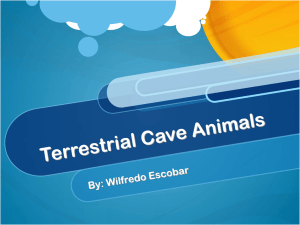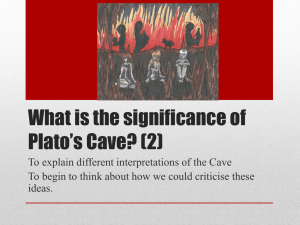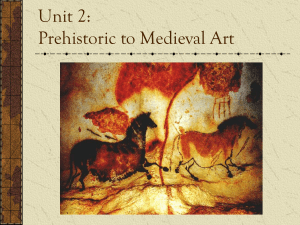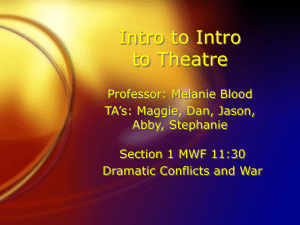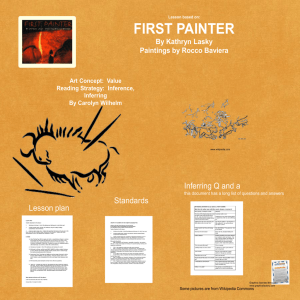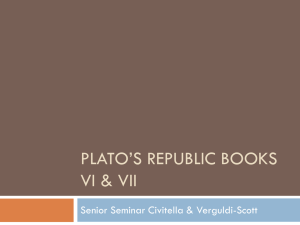The Myth of the Cave
advertisement
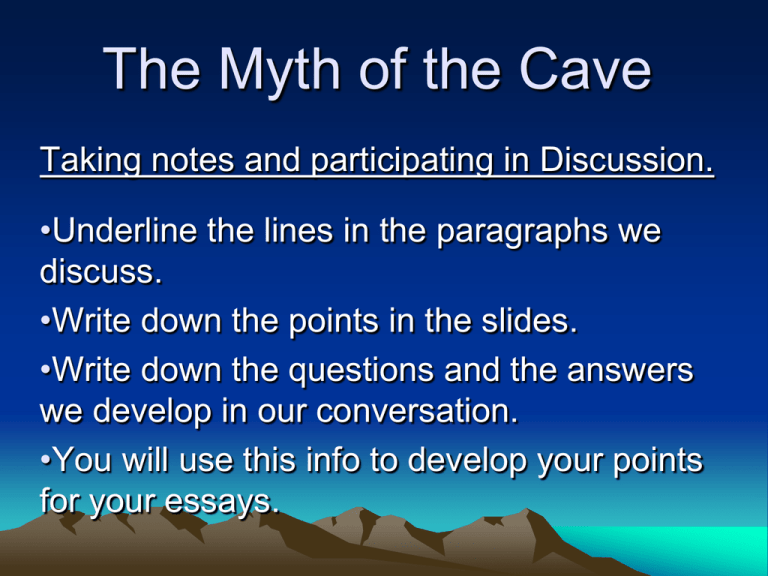
The Myth of the Cave Taking notes and participating in Discussion. •Underline the lines in the paragraphs we discuss. •Write down the points in the slides. •Write down the questions and the answers we develop in our conversation. •You will use this info to develop your points for your essays. The Myth of the Cave •Allegory •1. A representation of an abstract meaning through concrete forms; figurative treatment of one subject under the guise of another. •2. A symbolical narrative The Myth of the Cave • Dialogue—A literary work in the form of a conversation b/w two people • Di—A Greek prefix meaning two • Contemporary meaning allows for dialogue to be defined as conversation b/w more than two people. The Myth of the Cave • This is not a story or an essay. • It is a dialogue. • It is an exchange between a teacher and his student, Glaucon, who mostly responds with affirmations. The Myth of the Cave • The selection comes from Plato’s The Republic, a cornerstone of Western philosophy and a building block of political, social, and legal thought. • In ancient Greece Socrates was Plato’s teacher. • “The Myth of the Cave” is Plato’s recording of a lesson that Socrates taught him. The Myth of the Cave • The situation the teacher describes is a group of men who are chained in place in a cave. • They are content in their place. • They view shadows on the cave wall that are cast by manipulations from outside the cave. The Myth of the Cave • One man eventually breaks free and ‘sees the light.’ • He returns to the cave to share what he has learned, but his former cave mates call him mad. • This parallels human behavior through the ages. • Again it is not literal; it is a figurative. The Myth of the Cave • Taking notes and participating in Discussion. • Underline the lines in the paragraphs we discuss. • Write down the points in the slides. • Write down the questions and the answers we develop in our conversation. • You will use this info to develop your points for you essays The Myth of the Cave • Paragraph 1—The first two lines articulate the purpose of “The Myth of the Cave.” – A figure about the extent of our enlightenment. • Paragraph 5—They see only shadows. The Myth of the Cave • Paragraph 6—how could they be expected to see anything beyond what they are shown. • Paragraph 9—truth would be nothing but shadows. • Question: What are some example of shadow truths—truths we are simply expected to ingest and regurgitate? The Myth of the Cave • Paragraphs 11-15, • What will happen when prisoners are released and “disabused of their error”? • How will they respond? • Why will they not be able to see “the realities of which in his former state he had seen the shadows”? The Myth of the Cave • How do we get to the point when we can recognize that what we once thought was truth was, in fact, an illusion? • Do we seek refuge in our illusions? The Myth of the Cave • The light will dazzle b/c it blinds. – In other words, truth that replaces our illusions takes time to settle. • Paragraph 19—Growing accustomed to the light occurs in steps. The Myth of the Cave • Paragraph 17 and 19—The cave escapee achieves pure, full sight when he sees that the sun is the source of light (and virtually everything else). • Paragraph 27—once the former cave dweller has achieved full sight (disabused himself of his illusions), he will recall his cluelessly blind friends back in the cave. The Myth of the Cave • Paragraphs 33—The enlightened cave escapee upon his return to the cave would “compete in measuring the shadows with the prisoners who had never moved out of the den…” • This means that he would have his new knowledge held on equal ground with the blind idiocy of cave dwellers who have not achieved full wisdom. The Myth of the Cave • Paragraph 33—His stupid cave friends would mock him and call him confused. • They would also say that it is better to stay in the cave than to leave and return with weird ideas. • Question: What examples in our lives and time could illustrate this? – Think racial tolerance The Myth of the Cave • Paragraph 35. • This paragraph identifies the literal representations of the events in the allegory. • The cave is what we are shown in the world. • The journey out of the cave is the pursuit of knowledge and wisdom. The Myth of the Cave • Paragraph 35 continued—“in the world of knowledge the idea of good appears last of all, and is seen only with an effort…” • Meaning, when pursuing knowledge, full wisdom is recognized only with great effort and determination. The Myth of the Cave • Paragraph 39—Once man has achieved enlightenment, he will be able to fight for justice, etc. The Myth of the Cave • Cave Examples: • “That’s gay!”—Morons say things like this b/c they lack the insight or the motivation to figure out what the nature of the issue is. • Also, they lack basic abilities with the English language. The Myth of the Cave • • • • • Cave Examples: Copernicus and heliocentrism. Galileo and earth as a globe, not a plane. Al Gore; yes, Al Gore! People who shake us out of our inert comfort zones, our stagnant status quos. • Think of some more examples!
